Corinne Mucha is a Chicago-based cartoonist who makes funny and thoughtful comic memoirs. Her latest book about a messy break-up, Get Over It, was published in June by Secret Acres. Mucha’s comics are rarely straightforward stories; they often feel instead like variety shows with her personal anxieties as the performers.
Mucha’s loose narratives are full of tangents and asides but they always remain tethered to a unifying theme and end in a reflective insight. A hilarious tale about childhood fears of being kidnapped by witches becomes an observation about the way our minds create false memories. Lately, her comics have shared insights commonly gained through mindfulness practice.
Mindfulness is a meditation practice that has captured a lot of attention in recent years, crossing over into Western psychology and pop culture. With roots firmly in Buddhism, it involves a conscious awareness of your present thoughts and emotional state. Jon Kabat-Zinn describes mindfulness as “paying attention in a particular way; on purpose, in the present moment, and nonjudgmentally. This kind of attention nurtures greater awareness, clarity, and acceptance of present-moment reality.”
Whether those insights derive from personal experience (her comics depict her practicing yoga and she recently illustrated a guided meditation app), or if they stem from a larger Eastern influence on our culture is unclear. But reading her work through the lens of Eastern thought helps to articulate the study of mindfulness and find connections between the themes of her comics.
Opening the House of Worry
In the introduction to Get Over It, Mucha declares that this story is “the saga of one relationship’s undoing.” This statement is a bit misleading. For sure, Corinne’s character spends a lot of time obsessing over the details and hypotheticals of how her relationship with Sam fell apart. But as readers, we are spared much of this analysis; the real source of conflict in the comic is between Corinne’s brain and her heart.
They struggle with an on-off relationship with Sam, who manages to love and reject her at the same time. Her heart vacillates between affection and pain as her brain fights mightily to find reason and order. Running laps, her brain searches for answers and berates her to the point of self-flagellation. She can’t sleep, she obsesses, and she’s always on the verge of tears.

The Buddha said, “I teach one thing and one thing only: suffering and the end of suffering.” Corinne struggles mightily to control her emotions and to push away her heartbreak, her resentment, her feelings of regret, doubt, fear, and self-loathing. But the suffering persists. Her brain explains that her heartache will not pass like a cold because it is “an inflammation you keep feeding.” So how does she end her suffering?
“The intention isn’t to chase [the feeling or thought] away, hate it, worry about it, or be frightened by it. So what exactly should you be doing concerning such thoughts and feelings? Simply acknowledge their presence.”
A common misconception about a meditation practice like mindfulness is that it helps you forget your troubles and escape to a sea of tranquility. In the Papercutter story “Growing Up Haunted,” a young Corinne listens to a tape of ocean sounds that instructs: “Put all your worries in a box. Throw the box away.” But true mindfulness is not about chasing away your difficult feelings; it is about seeing them for what they are – just passing states of worry, anxiety, resentment, anger. They can never go away entirely; removing all the “bad” feelings would by necessity remove all the “good” feelings. “Thoughts are not the problem,” Genpo Roshi says, “the problem is what we do with our thoughts.” Negative emotions themselves do not cause suffering.
According to the Buddha, “attachment is the root of suffering.” Because we are attached to our own bodies and minds, we believe we can control them. Sharon Salzberg describes attachment’s two accompanying qualities, seeking and guarding: “Seeking is endless. It never comes to a state of rest; it never ceases. Guarding involves trying to hold on, and this creates fear and anxiety, because everything we can know with this body and mind is in constant change.” When Corinne asks how she can let go of her heartbreak, she is asking how to stop holding onto it. Ignoring it, fighting it, and running from it, does not seem to work.
Mucha’s minicomic It Doesn’t Exist contains a story called “The House of Worry.” She imagines the construction of a secure fortress to store her anxieties. Worries are extracted from her body and transported in a steel box to a storage facility. Each worry is analyzed, categorized, and given its own floor. By exhuming every anxiety she has, she imagines a calm, carefree life.
The primary problem with actively pushing out difficult emotions is that instead of letting them pass through, as in mindfulness, they never really go away. More security is required for the fortress and, it follows, more anxiety about the security.

Mucha concludes in Get Over It: “Letting go is not a thing to be won, especially through harshness. It is not a thing to be expelled. It is not a thing that can be yanked or seized or grabbed. It is a slow thing that can be found by slowing down.”

In order to get over her heartbreak and allow her pain to pass, Corinne realizes that she must stop fighting her emotions and listen to them instead. This state of observation is the primary condition of mindfulness practice. “Learn to watch your drama unfold,” Ram Dass says, “while at the same time knowing you are more than your drama.” In order to let go, Corinne must enter this state of observation, which would allow her to stop identifying with her emotions. Otherwise, she cripples herself.
“It is crucial for us to see that when we identify with these passing states as being solid and who we truly are, we let them rule us, and we are compelled to act in ways that cause harm to ourselves and others. Our opening needs to rest on a basis of nonidentification. Recognizing aversion or anger in the mind as transitory is very different from identifying with them as being who we really are, and then acting on them.”
By slowing down and acknowledging her heartbreak, she can cultivate compassion for herself. If compassion is an act of putting others’ needs before your own, dropping her identification with her heartbreak is a prerequisite. She can treat herself with the same care, tenderness, and forgiveness that she would offer a good friend. Mucha illustrates this beautifully in a series of panels where she and her heart, haunted by painful ghosts, sit down together to share a pot of tea.

Is it the Future Yet?
Acknowledging that our emotions are not who we truly are allows us to see them as transitory states. This is a challenge in Get Over It; the brain’s insistence on maintaining control is motivated by the heart’s desire for permanence. Mucha depicts change as the heart’s perceived enemy.
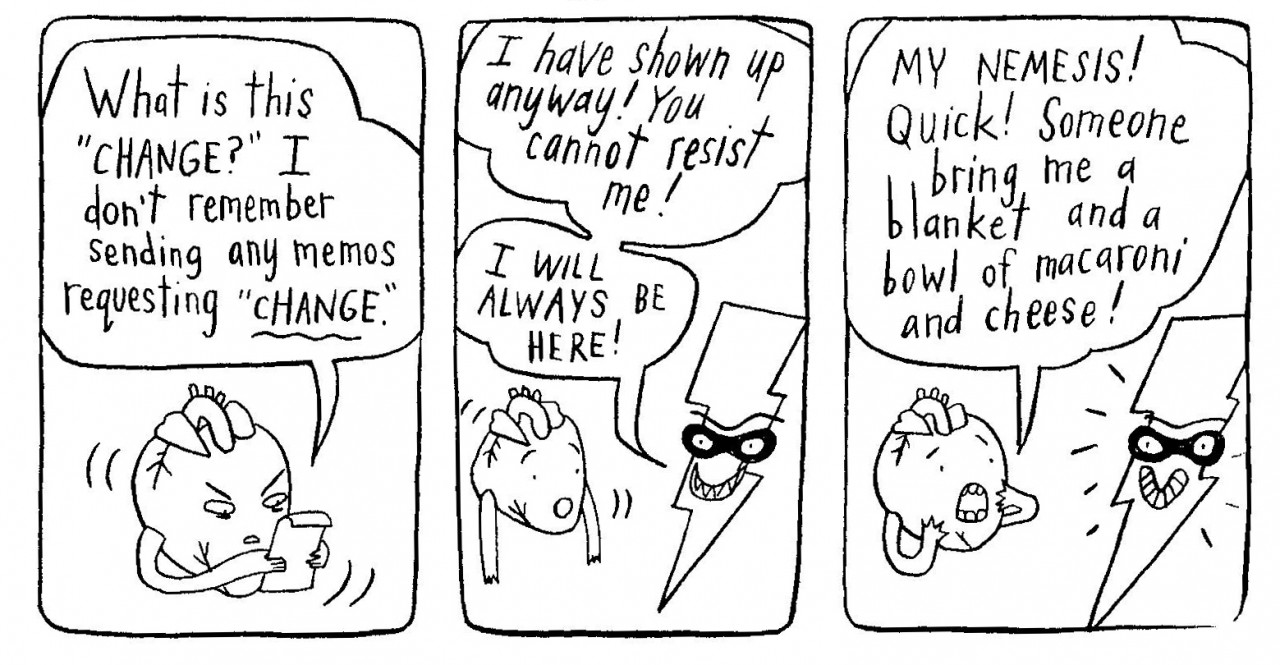
While the heart clings to the past, the brain fixates on the future. Mucha identifies the catalyst for the breakup as the point when Corinne asks Sam, “Where do you see our relationship going?” Their conflicting stories about a hypothetical future (she sees a long marriage, he sees a few years) appear more important than the health of the current relationship. Mucha notes the futility of suffering through an unhealthy relationship simply because the couple’s imagined futures are more closely aligned. This is a fallacy similar to the poor decision to have a baby in order to “save” a failing marriage.

The future is another illusion that must be dispelled. Because the “plan” of a relationship is tied to the personal goals and desires of its participants, a breakup feels like a failure. Mucha illustrates the future relationship as something to fight for, as if you are the hero in a romantic comedy. She eventually defines letting go as “surrendering to things as they are instead of how you think they should be.” Jon Kabat-Zinn elaborates: “To let go means to give up coercing, resisting, or struggling, in exchange for something more powerful and wholesome which comes out of allowing things to be as they are without getting caught up in your attraction to or rejection of them, in the intrinsic stickiness of wanting, of liking and disliking.”
The conflict between how things are and how they should be is at the heart of “The Modern Quest,” another story from It Doesn’t Exist. Here, the search for perfection is also seen in terms of a fight where “the battlefield is the body, the mind. That thing we call a life by the lines we draw to limit it.” The quest destroys us as we fight against ourselves for a future that never comes. Every success is a failure because the more you succeed, the more you need to continue succeeding.

The notions that our relationships can head somewhere, that our lives can be controlled, and that we can attain perfection, are encouraged by our society’s consumerist attitude. After working towards and attaining fictional goals like grades, graduations, and quotas, we hope to gain all the promises of retirement. We pass this mentality onto our children, who will have “better” lives than ours. Alan Watts describes this promise as a hoax, insisting, “You will never, never be able to sit back with full contentment and say, ‘Now, I’ve arrived!’ Your entire education has deprived you of this capacity because it was preparing you for the future, instead of showing you how to be alive now.”
Although mindfulness can be a way out of this pattern, it is still commonly marketed as a tool for self-improvement. This is precisely what the Buddha meant by the trap of “seeking,” even in regards to enlightenment. In the words of the monk Linji, “If a man seeks the Buddha, that man loses the Buddha.”
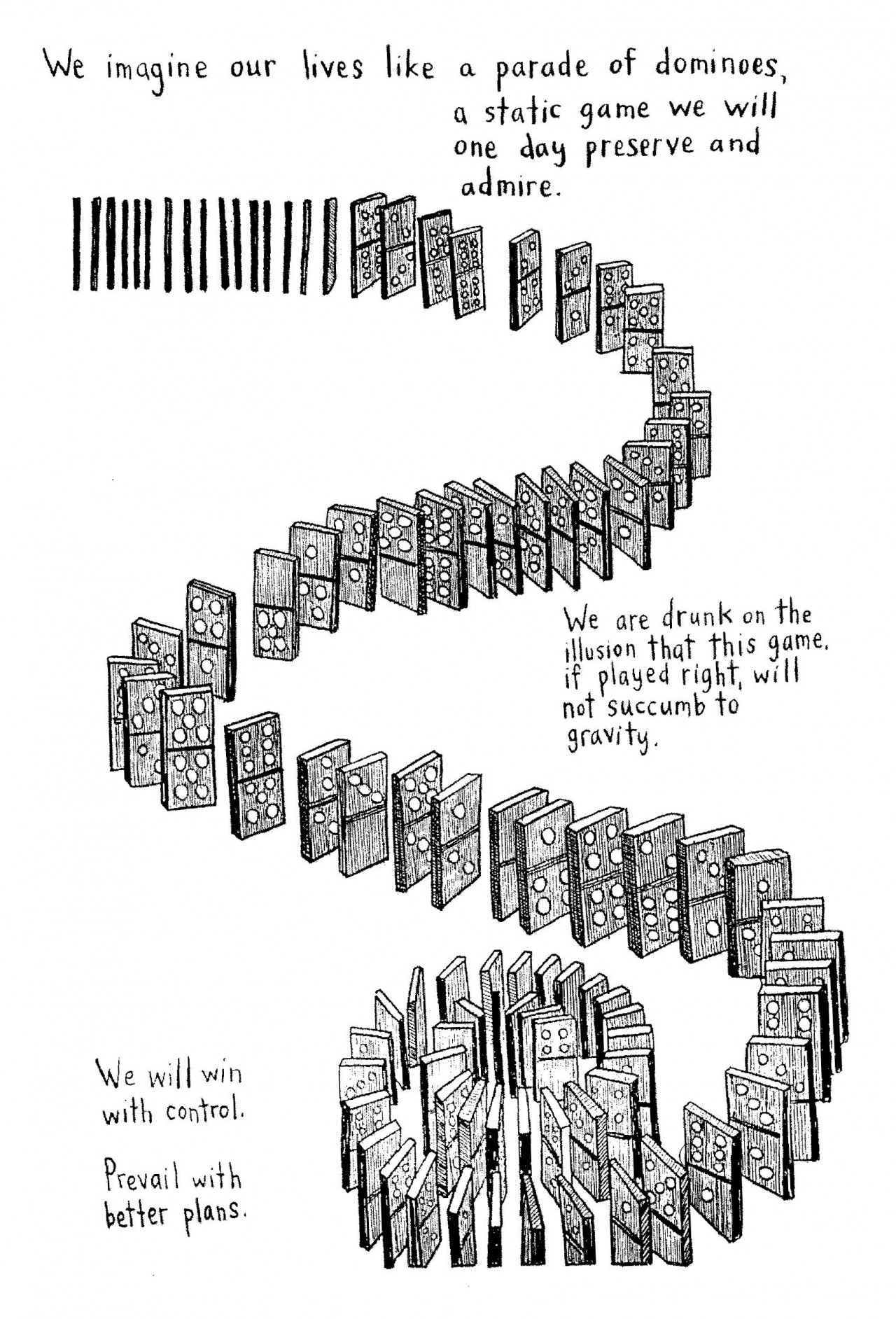
Mucha’s minicomic, Is it the Future Yet? shows this quest as it was manifested in her childhood. Mucha describes a period when she believed that déjà vu to be a sign that she was on the right path. Not only was she living for future goals, those goals were hidden from her. She just knew that she needed to make choices that kept on her “on track” toward… something.

The fear that things will not turn out well – even though she is unable to truly articulate what “well” is – leads to a paralyzing anxiety. She worries, “Was I supposed to say that? Was I supposed to do that?” This anxiety continues in her adult life. She has not given up the notion that she must make certain choices in order for her future to turn out right – even a future that is free from anxiety.

Spending time speculating and worrying about the future is useless, according to Thích Nhất Hạnh. He writes: “We can only take care of our future by taking care of the present moment, because the future is made out of only one substance: the present. Only if you are anchored in the present can you prepare well for the future.” In the comic, Mucha directly address this conflict. She imagines that In the future, she will finally be able to live in the present. And in the future, she will stop imagining the future.
In these anxiety comics, she presents the problem with seeking the future and the contradiction of clinging to it. In her subsequent work, she reveals how to escape.
The Hands of Perception
The quest for perfection falls apart when we realize, according to Mucha, “you can’t reach a destination whose coordinates you keep shifting.” Once you recognize that your destination is unfixed, then your destination is everywhere. Mindfulness helps us recognize this by forcing us to sit quietly, doing nothing.
Because Corinne’s struggle to get over her relationship with Sam is based on an imaginary destination, a connection can be drawn between the insights Mucha as an artist makes in It Doesn’t Exist and the growth Corinne the character finds in Get Over It.

The question of “Where is this relationship going?” is replaced with “Where is this breakup going?” She has a deadline based on a mathematical formula and is frustrated when she doesn’t meet it. Her only solution is to stop moving.
“If we just sit and do nothing, we will eventually reach the state where nothing is happening.”
By sitting quietly, doing nothing, and listening to our thoughts, our illusions about who we are – and who we should be – fall away. This is not an easy thing. It is difficult to do nothing, and if we actively start listening to our thoughts, our minds chase their own tails, thinking about thinking. Mindfulness teaches techniques that help us to adjust our consciousness. The techniques usually involve a focal point, like your breath, to concentrate on while your mind chatters away. When you start listening to your breath, your brain tries to regulate it. Eventually the breathing happens on its own, unconsciously. Listening to your thoughts, your mind wants to control them as well (in meditation, it probably is spending most of its time telling itself to be quiet). Eventually, like the breath, the thoughts happen on their own. When we listen to our thoughts happening, we must now wonder who we really are. If not our thoughts, then who?

In a classic story, a student visits the 17th century Zen master Bankei:
The Zen student came to Bankei and complained, “Master, I have an ungovernable temper. How can I cure it?”
“You have something very strange,” replied Bankei. “Let me see what you have.”
“Just now I cannot show it to you,” replied the other.
“When can you show it to me?” asked Bankei.
“It arises unexpectedly,” replied the student.
“Then,” concluded Bankei, “it must not be your own true nature. If it were, you could show it to me any time.”
When she stops moving, Corinne realizes she is not her heartbreak. She is not her heart, nor her brain. The past her heart wants and the future her brain wants are revealed to be illusions. Instead of viewing the present as an infinitesimally split-second in between the present and future, she awakens to the reality that the present stretches boundlessly.
On the final page of “The Modern Quest,” Mucha draws a series of hands that shift from drawing a linear representation of reality, what Alan Watts describes as a consciousness based on “single-track verbal thinking…which interprets the world by grasping little pieces of it, calling them things and events,” to a consciousness that joins both hands, creating a pool of negative space. This space could be a gateway, a breath, or a mouth forming “Om.”

“In this moment there is nothing which comes to be. In this moment there is nothing which ceases to be. Thus there is no birth-and-death to be brought to an end. Wherefore the absolute tranquility (of nirvana) is this present moment. Though it is at this moment, there is no limit to this moment, and herein is eternal delight.”
The Tao of Panel Borders
Like yoga, mindfulness is called a “practice” because it does not have a goal. There is never a point where you get a certificate and can live in harmony. To assign a “purpose” to the practice misses the whole idea. But just because you recognize that nature does not have a destination, that your “self” cannot enforce or prevent change because it is change, that reality is only “this” – it doesn’t mean that the trappings of your life and identity are meaningless. Mindfulness is not moral instruction. It is not a religion. It is a Buddhist practice that, in the Zen tradition, has more to do with finding reality than finding spirituality.
Mindfulness allows you to find your capacity for happiness in the present moment. It allows you to face pain, heartache, and trauma, without being destroyed by it. It allows you freedom from acting self-consciously. And it allows you to laugh at yourself.
Corinne Mucha laughs at herself. She embraces the pliability of the fiction our culture perpetuates and always looks for new balls to play with. Her panel borders are never artificial, rigid rectangles, but curved enclosures with wavering lines. She depicts herself having conversations with plants, lamps, and coasters. While sourced from life, her comics abound in puns and fantasies.
“This is the real secret of life – to be completely engaged with what you are doing in the here and now. And instead of calling it work, realize it is play.”
This ability to present the world as it is experienced, while playing with its elements enough to reach genuine insight, defines transcendence. This is how she connects with her readers and it is the reason we cherish her comics.
The Monkey in the Temple
Years ago, a student of Zen attended to two nuns in the city of Edo. One evening, she was carrying water into the temple when she spotted a creature’s slim grey tail. The creature scurried into the temple, out of sight. She did not know its name.
The next morning, the student meditated. A thought crossed her mind – the image of a monkey. Certain that the creature she saw was a monkey, she sought the two nuns.
“There is a monkey living in the temple,” the student said.
“How do you know there is a monkey?” one of the nuns said.
“I saw its slim grey tail,” the student said.
“It could be a cat, a squirrel, or a racoon,” the nun said.
“You excel at naming animals. But this is a monkey,” the student said.
Hoping to show hospitality to the monkey, the student burned incense by the the entrance to the temple each evening. But the monkey did not appear.
She stood vigil for one week. Then a nun approached her and said, “I saw the animal last night. It is a squirrel.”
The student replied:

 Festival Season
Festival Season 

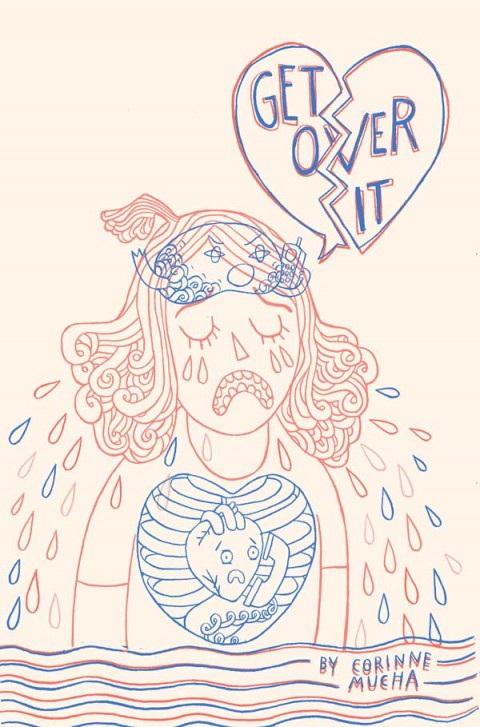


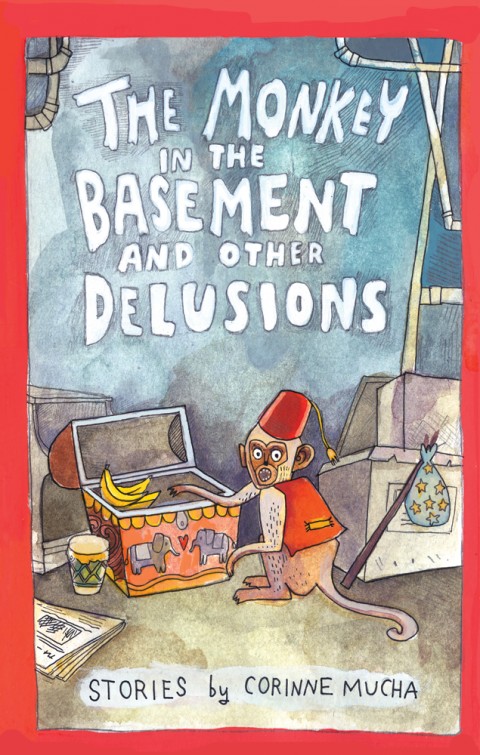
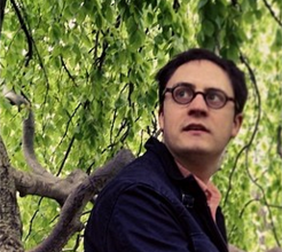

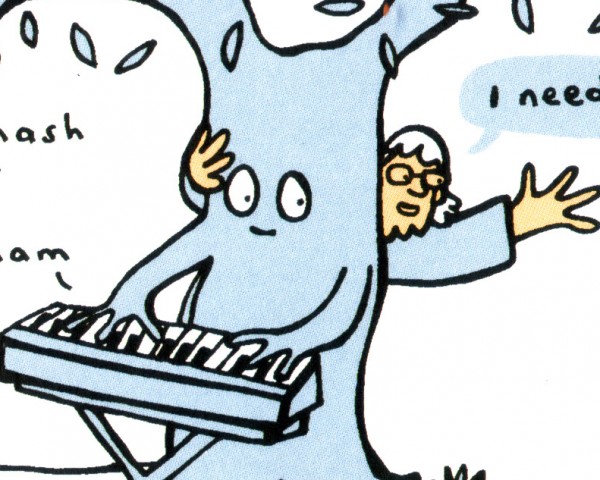

Really enjoyed reading the review, will have to check out her work. More of this please …. raising positive vibrations around the world
Thank you Kate! Corinne’s work is really special; I think you might like “It Doesn’t Exist” in particular!